Kei Tua o te Pae
Kei Tua o te Pae/Assessment for Learning: Early Childhood Exemplars is a best-practice guide that will help teachers continue to improve the quality of their teaching.
The exemplars are a series of books that will help teachers to understand and strengthen children's learning. It also shows how children, parents and whānau can contribute to this assessment and ongoing learning.
We are making improvements to our download-to-print functionality. So if you want a printed copy there are PDF versions available at the bottom of the main cover page.
Exemplars – Ngā tauaromahi
-
Nanny's story
Children's names: Matiu and Heremaia
Date: 23 July
A Learning Story
Belonging
Mana whenuaTaking an Interest Nanny came into Kindergarten today with Matiu and Heremaia. They were both proudly holding the pūrerehua they made with Nanny at home.
“Hoatu ki a whaea,” says Nan. Matiu gives me his pūrerehua.
“You know what it's made of?” he asks, smiling at me.
“I'm not too sure, Matiu, can you tell me?”
“I made it from fish heads, me and Nanny, see?”
“Were the fish heads nice?” I ask.
“Mmm, yeah” he replies.
Nanny told me that they did a karakia and gave the first fish back to Tangaroa (Guardian of the Sea), then they caught some more. Those ones they took home and ate them for kai.
Then Matiu, Heremaia and Nan made the pūrerehua from the fish heads. I asked Matiu and Heremaia if they would like to put their pūrerehua into the office so they were kept safe.
Matiu asked if he could have news today at the mat.
“I think that is a good idea, Matiu.” We leave the wonderful pūrerehua in the office ready for mat-time.
Well-being
Mana atuaBeing Involved Exploration
Mana aotūroaPersisting with Difficulty Communication
Mana reoExpressing an Idea or a Feeling Contribution
Mana tangataTaking Responsibility Short-term review
What a wonderful learning experience for the family to share with the other children. Nanny felt comfortable to share her knowledge and this wonderful activity she did with her mokopuna and with the teachers.
Nanny's knowledge of Te Ao Māori is reflected in the conversation and is shared with teachers (e.g. Karakia).
Thanks for the wonderful idea, Nanny, all we need to do now is catch a fish!!!!
-
A gift of fluffy slippers
-
Child’s name: Vini
Date: November
Teacher: Rosie
A Learning Story
Belonging
Mana whenua“My Mother's slippers are broken,” Vini explained to me. “I would like to make her new slippers,” he continued.
“Great, Vini – what a thoughtful idea … What do you think you need to make them?” I asked.
“Hmmm … cardboard … brown cardboard,” he decided.
I suggested that he draw around the shape of my feet – he agreed my feet were approximately the same size as his mother's. These were skilfully cut out.
“Next, I would like some material,” Vini decided as he fossicked through the fabric container. He produced the yellow fluff and together we negotiated our way around the shape of the soles. (Cutting sheepskin requires quite some effort!)
With the aid of the glue gun, the soles were attached along with the top of the slippers. Vini liked the way I slipped my foot into my shoes – his slipper design followed along the same theme.
“These are superb slippers, Vini! - have you finished them?” I enquired.
“No … not yet … they need a ribbon,” he answered.
It was to be the pink boa – a feathered strand tied in a bow with a blue pompom to top them off!
The wrapping process began … great thought went into the colour of the paper ad of the bow around the top of the parcel. Glitter and glue were used in the final finishing touches of his gift.
Vini presented his most precious gift to his mother after mat time …
Shalu held the beautiful slippers to her heart and, overwhelmed, she sighed and said …
“A gift to be treasured for a lifetime.”
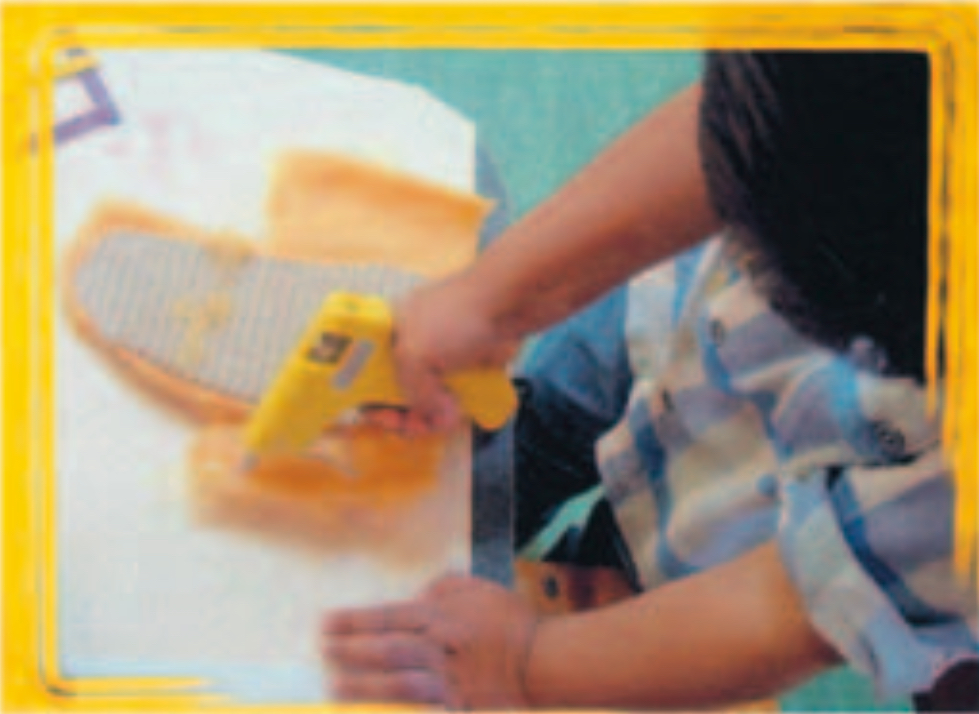

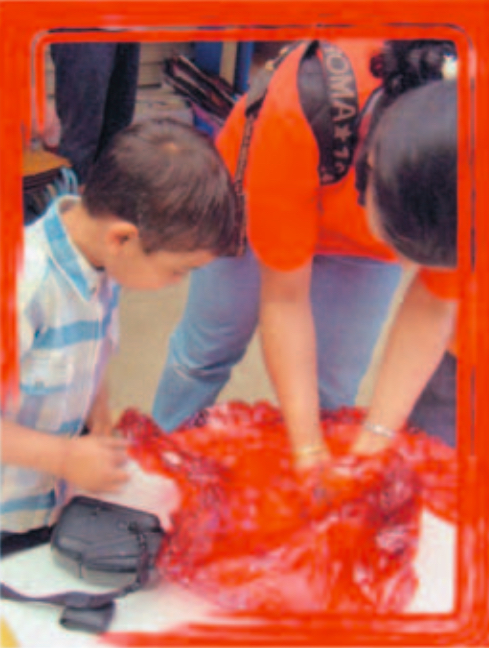
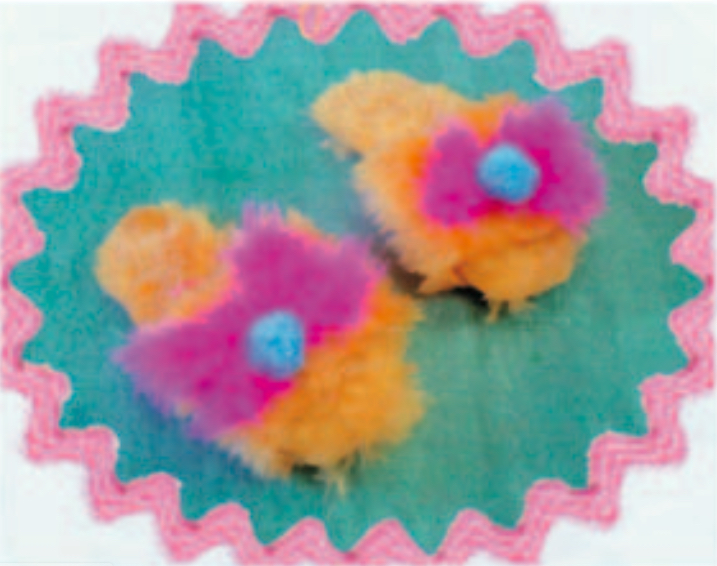
Well-being
Mana atuaExploration
Mana aotūroaCommunication
Mana reoContribution
Mana tangataShort-term review
What can I say, Vini? Words really cannot describe the thoughtfulness, caring and love you demonstrated today. Mummy was so right when she talked about a 'gift for a lifetime' … You are a wonderful example to us all … we are so incredibly proud of the person you are … may you continue weaving your magic forever.
Quote from part of the parent's voice
“Vini has been a very affectionate son from the beginning. But now here I have proof. The slippers he made for me were unbelievable in terms of thoughtfulness and technical perfection for a little child.
I am also very very thankful to all the teachers for helping him to be what he is today and what he will be tomorrow … Many thanks for spending all that time (and so patiently).
-
-
Exploring local history
-
Group learning story
October
After reading the story about Hinemoa and Tūtānekai, we talked about the carvings in the whare of Tūtānekai and what each part of the wharenui was called in te reo Māori. We talked about how they could have been made.
Grayson said, “Special carvers made them with hammers and knives.” The other children agreed.
Azia asked if she could make a whare. I said, “Sure. What do you think you could use to make it?”
Grayson said, “You could use the ice block sticks like I did, see?” She was pointing to the pictures that she, Joel, and Tessa had made of the wall of Tūtānekai’s whare.
Azia said, “Okay, but I want to make my own whare.”
Grayson, Joel, and Tessa had created their own whare and talked about how they should look while referring to the pictures that we found and the storybook.
What next?
Organise a trip to the local museum to see more Māori art and craft and also the maihi of a wharenui, because that really interested the children. The upcoming marae trip will also stimulate lots of discussion and interest.
Talk more with the children about the different parts of the wharenui and what they are called. This will provide an excellent lead-in to our trip to the marae, as the children will have an understanding of the physical aspects of the marae before we go.
Grayson’s learning story
Lately, we have been focusing on sharing New Zealand legends with the children. Their interest is continuing each day, with them asking for the stories to be repeated. We have displayed some kōwhaiwhai patterns in the art area to create an awareness of the beauty of these designs. Today, we made “te whare a Tūtānekai” after reading the local story about Tūtānekai and Hinemoa.
What wonderful interest and concentration Grayson showed in doing her work! She used natural materials and ice cream sticks to make her whare.
She came to me when her work was finished and said with a smile, “These are the Māori people inside.”
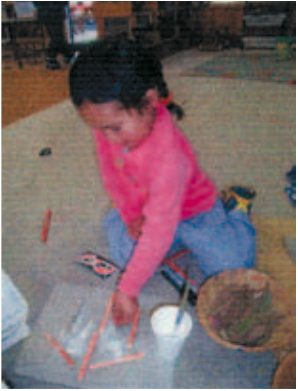
Grayson making her whare.

Grayson’s whare completed.
Grayson is developing an expectation that books can inform and excite and is also developing familiarity with stories valued as part of our New Zealand heritage.
Group learning story
November: Ihenga marae visit
Today, we went on a trip to visit Ihenga’s marae at Waiariki Institute. We travelled there on the bus in the rain. When we arrived, we waited in the gateway to be invited in by the tangata whenua of the marae.
Whaea welcomed us on with a karanga.
We then went inside and had a kōrero with Whaea about the whakairo (carvings) inside the building.
It was interesting to hear Whaea talk about the history and stories behind the whakairo, who carved them, and why the designs and stories were chosen. We heard of Ihenga and his travels around Aotearoa and how he named many places in this area and throughout Te Ika a Māui. She told us about Captain Cook and Abel Tasman.
We discovered that Ihenga named Ngongotahā after climbing the mountain and meeting the patupaiarehe, who gave him a drink out of a calabash. “Ngongotahā” means “to drink water out of a calabash”.The children enjoyed going around the wharenui and looking closely at and feeling the whakairo.
What next?
Revisit the children’s memories from the trip and talk a bit more about the history.
Talk with the children about designing their own whakairo and creating stories about them that relate to their lives.
Programme evaluation
Over the past few months, we have been exploring many stories about the history of our city.
Through our project on Lake Rotorua, the children have developed an understanding of its physical shape and the placement of Mokoia Island. Through the story about Hinemoa and Tūtānekai, the children developed their knowledge of the island’s history.
The rock warriors story provided a vivid story to explain the rocks that we see as we drive out of Rotorua on State Highway 5. The children really enjoyed this story. They asked for it frequently and created their own rocks.
Reading all these stories created another interest in Māori art and crafts. We explored this by creating new resources for the children to use and view, such as koru and kōwhaiwhai in the art area. A student teacher got involved in this interest by working with the children to create a cloak for the kindergarten.
The trip to the museum provided the children with information about the eruption at Mount Tarawera and the history of the Bath House. The museum also gave the children a chance to see a lot of Māori art and craft up close and to hear the history behind some of the pieces that relate to the iwi of this area.
The marae trip to Ihenga at Waiariki Institute helped to develop a link between the marae and our learning community and provided the children with the chance to experience pōwhiri and hear stories about he whakairo.
This has been a rewarding interest for all. All the children became involved and increased their understanding of our local history and culture, in particular, of Māori art and craft.
-
-
Sharing portfolios with the wider community
-
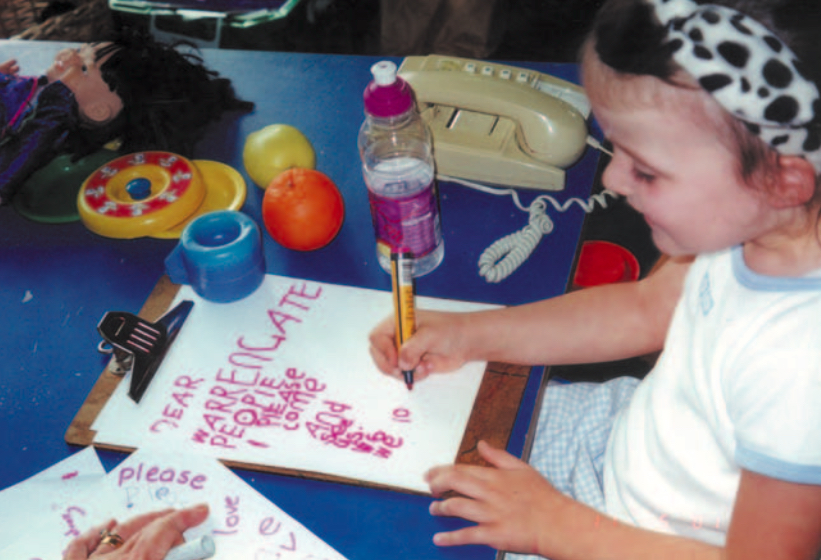
This was Anna’s idea. She decided what she wanted to say and only needed help with spelling some words.
Parent’s voice
Emma got very excited one evening as I put her to bed. She told me she was visiting Warrengate Hospital the following day. I told her there probably wasn’t a visit, as I had not received a notice about it. When we arrived at kindergarten the next day, I spoke to the teacher, who told us the Warrengate residents were visiting the kindergarten a few days later. We counted down the days, and Emma awaited the visit with great anticipation. She told me she particularly wanted to see a resident called Mr Shanks, who she had met on a previous visit.
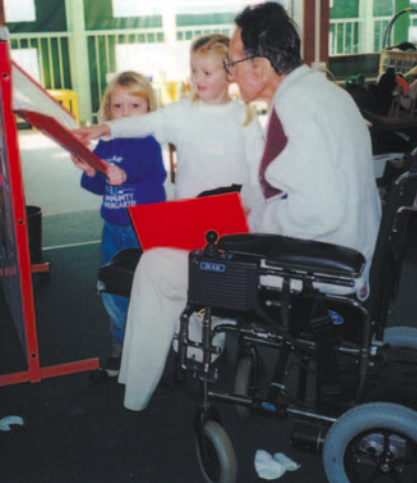
Emma and Mr Shanks
-
-
Rangiātea
-
Rangiātea, the 146 year-old historic church in Ōtaki, burned down in October 1995. The community was devastated.
The rebuilding has been a major undertaking that has touched the lives of many of the kindergarten children.

We took the children in small groups to visit Rangiātea. Whānau came with us. Many stories were told that we would not otherwise have heard.
One child’s great-grandfather’s carpentry tools were used – the planes were just like the ones used in the original.
Another child had gone with his dad to help dig the drains before the construction started: He didn’t build the church. He just dug the holes.Another child said I know about it. Someone went with a torch and matches and burned it down. The police chased him but couldn’t catch him. My mum told me.
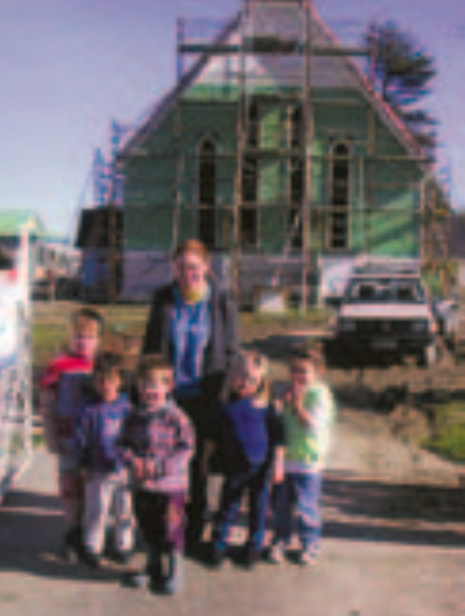
We walked through the town to get to the church and saw many familiar people. The children recognised many of the workers: There’s Uncle Skinny. Smile, we’re taking your photo!
There was lots of kōrero about scaffolding and pulleys and how the workers could stay on the roof. There was also kōrero to uncles and grandads in the urupā and karakia when we left.
One group met up with the priest who told them lots about how the old church had been built without nails. He promised to come and visit us at kindergarten.
The photos we took will become historic artefacts – these children saw history in the making. We have made a formal connection with the church that acknowledges our respect and the value we have for this building and what it stands for.
The next time we visit, we wonder what we will see. A roof? Windows? Children who pass by or visit it regularly keep us updated.
The learning that happened
- Kaiako made new connections with individual children’s whānau.
- Spiritual aspects about the urupà and the rebuilding became big conversation topics.
- Back at kindergarten, the children re-enacted the rebuilding in their block play.
- The children made deeper social, cultural, and whānau connections with each other.
Our assessment
The visit to Rangiātea fostered strong links to the community:
- inside the kindergarten with whānau;
- outside the kindergarten with community and whānau, too.
The experience allowed conversations to emerge, and we learned about different dimensions of our community.
The story continues ...
As the children get out the term books or their own kindergarten books and look at the photos and the newspaper cuttings, they remember and reflect. They update us on the progress they notice as they drive past the church.
Informing curriculum
At kindergarten, they build churches with blocks, including the scaffolding and often the urupà. There have been many conversations about deaths and burials.
The shared knowledge of the group consolidates their adventures and strengthens the connecting links between kindergarten and home.
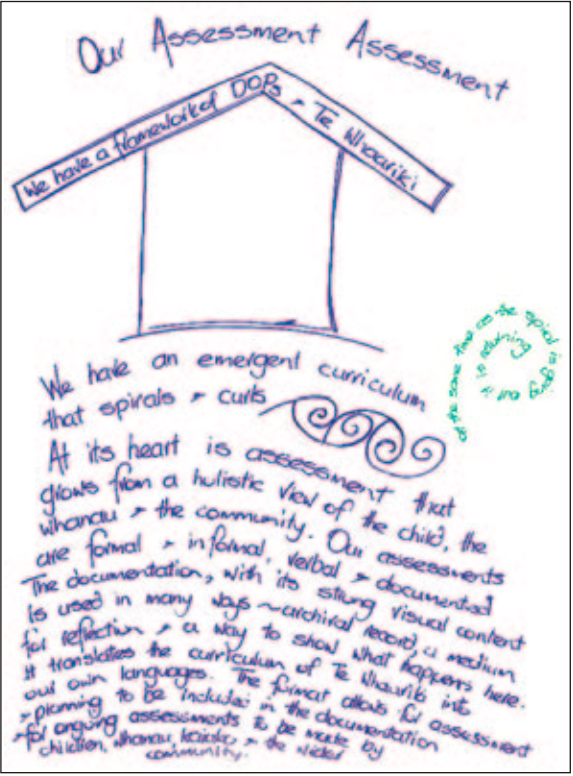
-
-
The flying fox
-
Child's name: Andrew
Date: February
Teacher: Karen
Examples or cues A Learning Story
Belonging
Mana whenua
Taking an Interest Finding an interest here – a topic, an activity, a role. Recognising the familiar, enjoying the unfamiliar. Coping with change. When Andrew's mum came to kindergarten today, she got Andrew's portfolio and began to write a Parent's Voice. Andrew's mum was writing a story about Andrew's exciting weekend.
Later on in the session, I asked Andrew to share his story with me, and he got his file and proudly showed me his mum's story. We had a great discussion about the fun he had had on the flying fox and his visit to the park.
I then suggested he might like to draw or paint a picture about his great weekend, and then we could write his story, too. Andrew decided to draw a picture and went and collected paper and pens.
As he created his picture, he explained how the flying fox worked and I recorded the words. After I had finished writing, Andrew said he would write his name.
Andrew asked to share his and his mum's stories at mat time. He very proudly stood up the front with his file and picture. He told the children about his flying fox adventure, and I read his story from his file.
Well-being
Mana atua
Being Involved Paying attention for a sustained period, feeling safe, trusting others. Being playful with others and/or materials. Exploration
Mana aotūroa
Persisting with Difficulty Setting and choosing difficult tasks. Using a range of strategies to solve problems when ‘stuck’ (be specific). Communication
Mana reo
Expressing an Idea or a Feeling In a range of ways (specify). For example: oral language, gesture, music, art, writing, using numbers and patterns, telling stories. Contribution
Mana tangata
Taking Responsibility Responding to others, to stories, and imagined events, ensuring that things are fair, self-evaluating, helping others, contributing to programme. 
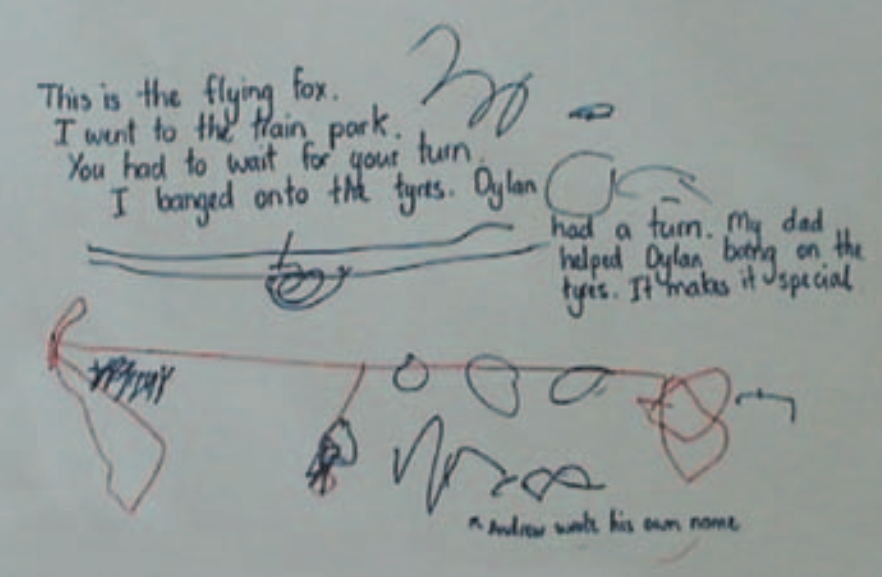
Short-term review
Thank you, Dantrea, for sharing Andrew's exciting weekend with us. This has given us an insight into Andrew's interest at present. It has also strengthened links between home and kindergarten and helps us to form a stronger relationship with Andrew.
It is great to see Andrew expressing his ideas and interests and teachers. [Belonging, goal 2.3]
What next?
Continue to encourage Andrew to share his news about what he does at home.
Record Andrew's ideas and thoughts in a story.
Encourage Andrew to use his name card when he is writing his name.
More Parent voices would be great!
Parent's voice
Last weekend, Andrew, Dylan, Mum, and Dad went to Cornwall Park.
Andrew's favourite toy was the flying fox. He kept telling all the kids to hold on very hard. Dylan had a turn too. The also played on the train, slide, swing, and more. We all had a great time.
I would like to see Andrew sharing his stories with his friends at the kindergarten mat time.
-
-
Growing trees
-
Children: Thomas and Isaiah
26 February
Teacher: Margaret
It’s our centre’s first birthday and distinguished guests have come from afar to help us celebrate. Isaiah and Thomas stand around the birthday cake with other tamariki.
Some of our guests donate trees to the centre. We were so lucky to receive two silk trees, two kauri trees, and an olive tree.
During morning mat times, we discuss the trees we received for our birthday in detail, thinking about the process that they may take to grow and develop. The tamariki take an interest and assist in digging the holes for the trees, planting the trees, and giving small karakia to Tāne Mahuta to help our trees grow.
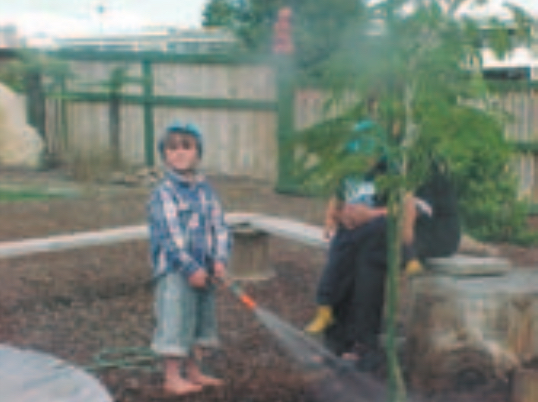
Watering the trees takes on a new meaning for Thomas as he waters one of the silk trees. Whaea Margaret explains that the trees need to be watered every day to help them to grow. Naming the trees as they are watered helps the tamariki to recognise the differences between them. Isaiah says, “There’s silk trees at the kindy too, aye Whaea?” (referring to his last kindergarten). Whaea agrees and says, “One day our silk trees will be just as big as those ones.”
Thomas and Isaiah count and name the trees as they water them. Soon, other tamariki take an interest and ask if they can have a turn at watering the trees.
Short-term review
Thomas and Isaiah take an active part in any discussions that arise about the growth and development of plants and trees.
Tuakana-teina relationships develop as a result of Thomas and Isaiah’s interest. (That is, both boys show the younger tamariki how to water and care for our trees and help them to recognise certain trees.)
What learning occurred here?
Science, maths, social skills, co-operative play, tuakana-teina relationships, and communication skills.
What next?
A programme on the theme of autumn and what happens when leaves change colours and fall to the ground.
Discuss and provide hands-on experiences of animals that may use some trees as homes (for example, birds and insects).
Give the tamariki an awareness of Tāne Mahuta and his role and importance to Māori (for example, through discussions, waiata, and looking at pictures of the ngahere [forest]).
A trip to the ngahere.
Evaluation
Still evaluating. The programme is ongoing.
Thomas was very excited about his painting. “Look, Whaea Aggie, I drew a silk tree.”
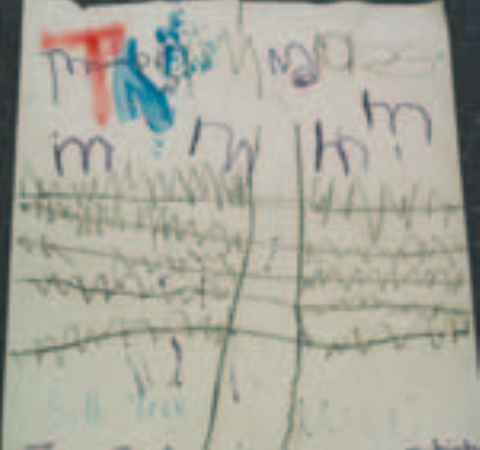
“Ka pai, Thomas, he ōrite tō rākau, ki ngā rākau a waho (your tree looks just like the trees outside),” Whaea Aggie tells him.
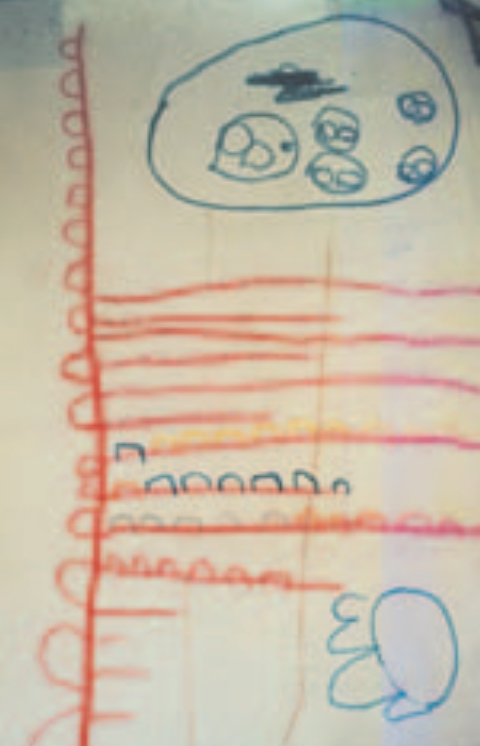
Isaiah explains: “I dig a big hole. Isaac and Whaea Helen filled the hole with water.”
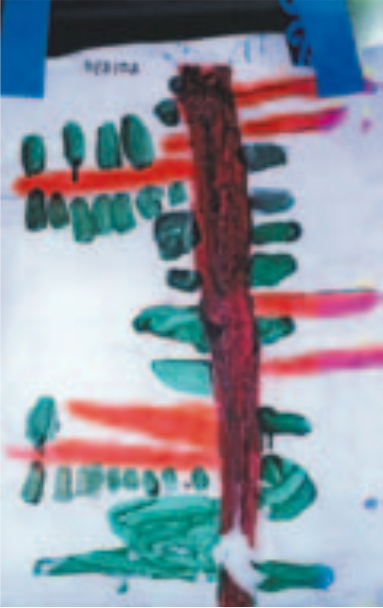
Isaiah also painted a wonderful silk tree. He knows how to care for our silk trees and can name the other trees that were donated at our first birthday.
Somebody else has made a wonderful effort as well. Ka pai e tamaiti.
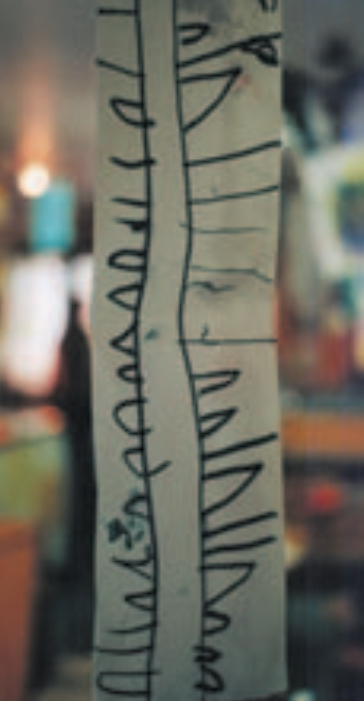
Learning story: autumn
To extend the theme in the previous story on the growth of trees, the centre is looking at the theme of autumn, with staff and tamariki making their own tree. We are putting leaves that have fallen from the trees in our environment onto our tree trunk.
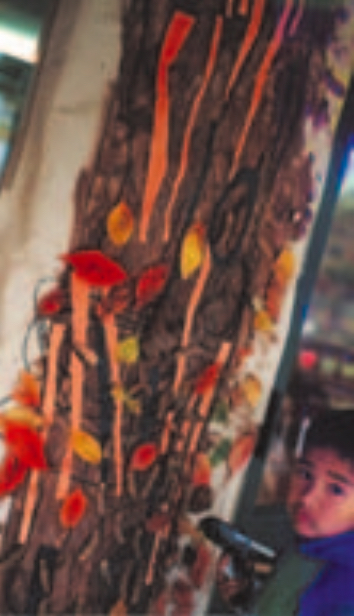
The leaves on our tree have a new home. There are lots of different- coloured leaves that we picked up off the ground around the centre.
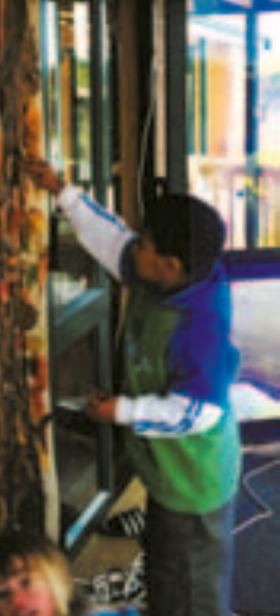
Tyscheen does an excellent job of gluing fallen leaves onto the tree that most tamariki helped to paint. Using the glue gun also has its benefits ... it’s fun to use!
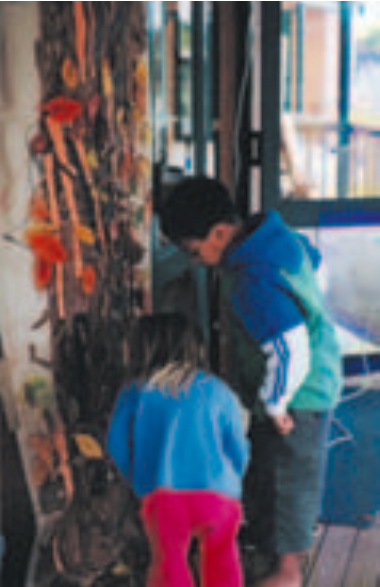
Tyscheen helps Eden to stick leaves onto the tree with the glue gun. Ka rawe korua.
-
